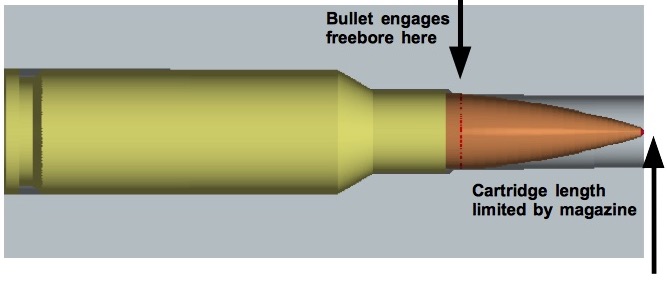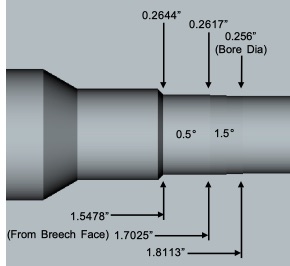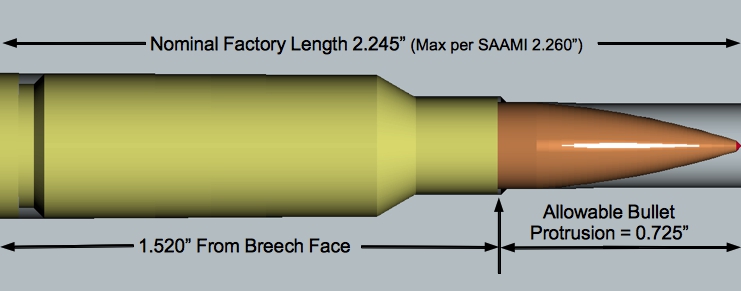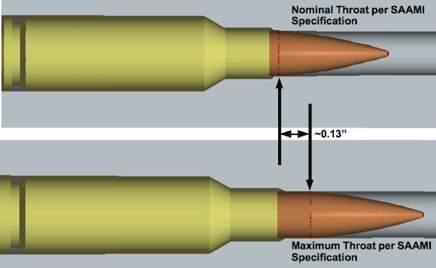Section 1 — Why are Tapered Throats Reappearing?
Classic cartridges like the 6.5X55 Swedish, 7×64 Brenneke, .303 British, 8 mm Mauser, 30-06 Springfield, and others have no freebore in the standard SAAMI or CIP definitions. Nonetheless, these cartridges are capable of excellent accuracy with a variety of bullets.
We see in this illustration that tapered throats have no defined freebore and taper from slightly greater than the bullet diameter to bore diameter with no break in the slope:

Figure 1 — Diagram of a Brenneke-style throat
The current standard freebore and throat starts with a cylindrical section of a defined length followed by a more aggressive taper to bore diameter:

Figure 2 — Diagram of a throat with freebore
We can see from the chart below that these cartridges were all introduced well before World War II(1) and have tapered throats. The 30-06 with a 1º 22’ taper was different from its arguably contemporary European counterparts but, like them, has no freebore. More modern cartridges like the .308 Winchester tend to have a freebore (constant diameter section slightly larger than the bullet) of a length set by the cartridge designer.
A casual review of the SAAMI and CIP drawings suggests that almost all cartridges introduced prior to World War II have no freebore and that most cartridges introduced post war are designed with a freebore. Interestingly, the 270 Weatherby magnum was introduced in 1943 with the extraordinarily long freebore of 0.347 inches. Starting roughly with the 7.62×51 NATO (.308 Winchester) introduced in 1950, freebore in chamber designs become essentially a standard feature.
The Weatherby freebore allows the bullet to accelerate without resistance from engraving by the rifling until after it has a fair amount of velocity and the combustion volume is larger than prior to primer initiation. These features allowed a more benign pressure build for the smokeless powders on the market in the 1940s. One can speculate that the freebore allows somewhat more convenient quality control during reamer grinding. Further, the opportunity for slight jumps gave an additional accuracy parameter(2) for reloaders and professional load developers. These features at least partially explain the current near-universal use of freebore designs in contemporary cartridges. SAAMI(3) and CIP(4) cartridge drawings show that the throat tapers for these example cartridges are all less than 1 degree:
| Cartridge | Throat Taper | Year Introduced |
| 6.5×55 Swedish | 0 deg 42 minutes 29 seconds | 1894 |
| 7×64 Brenneke | 0 deg 17 minutes 11 seconds | 1917 |
| .303 British | 0 deg 31 minutes 45 seconds | 1888 |
| 8 mm Mauser | 0 deg 17 minutes 11 seconds | 1903 |
Fast forwarding from the mid-20th century to the beginning of the 21st century, we see the beginnings of a return to the tapered throat starting with the introduction of the 6.5 Grendel in 2003. This introduction was followed in 2018 or 2019 by serious wildcat design efforts by Nathan Foster(5) at ballisticstudies.com and David Manson(6) at mansonreamers.com. Nathan’s discussion about cartridges with Brenneke throats is toward the end of the the “Knowledge Base” section of his web site.
The discussion below is a slightly edited paper the author drafted in 2015 to help bullet designers and handloaders better understand the 6.5 Grendel compound throat. The author did not realize at the time that the discussion applies equally well to the broader class of Brenneke-throated cartridges. The discussion is therefore included here for the larger audience.
The answer to the section title is the secret sauce in the Brenneke throat:
The taper starts immediately in front of the neck which minimizes clearance between the bullet and the throat. There is ALWAYS less clearance between the bullet and throat than is possible with a freebore. The result is less opportunity for misalignment as the bullet starts moving.
Section 2 — Optimizing Bullets for Accuracy in cartridges with Tapered Throats:
The very long, gentle throats represented by the Brenneke and 6.5×55 Swedish are very different from our current canonical constant diameter freebore followed by a taper in the vicinity of 1.5 degrees. There are nuances that are not well understood by many handloaders and bullet designers accustomed to the currently standard freebore and throat. The 6.5 Grendel cartridge and chamber design adds to the mystery by enjoying a Brenneke-style taper followed by the more familiar 1.5 degree tapered throat section.
To start our discussion, we note that most modern cartridges have SAAMI maximum pressures well above that of the Grendel (52,000 psi or the CIP equivalent). Nonetheless, some cartridges have less than 52,000 psi SAAMI maximum pressures. Further, factory load operating pressures 2,000 to 3,000 lower in factory cartridges. The bullet designer should be attentive to alloy strength when selecting materials for bullets optimized for lower pressure cartridges.
Second, the very slight taper in Brenneke throats starting at the end of the neck makes the first contact much closer to the case mouth than one might expect by the start of the more aggressive canonical 1.5 degree taper starting at the termination of the freebore. This first contact point establishes the longest nose or ogive possible with minimum jump when keeping the cartridge length within that easily and reliably used in the magazine.

Figure 3 — The maximum ogive length is set by the difference between where the freebore is engaged (first point of contact) and magazine length.
Considerations for alloy selection are discussed first, followed by an assessment of the maximum practicable nose length for optimal accuracy in the Grendel. Bullets designed using these considerations should also yield good accuracy in other modern and classic cartridges like the 260 Remington, 6.5 Creedmoor, 6.5 x 55 and so on.
A. Alloy selection:
The alloy selection should be based on yield strength as well as machinability and formability.
One of the challenges in the cast bullet community is ensuring that the peak pressure is at or above the yield strength of the bullet alloy so that the bullet base expands into the bore, causing an effective seal. The consequences of not meeting that threshold are gas-cutting of the bullet resulting in decreased accuracy and excessive leading with cast bullets. This issue also can result in copper fouling with jacketed and lead-free bullets.

Figure 4 — Obturation results from the tendency of pressure on the base of the bullet to cause expansion on the unsupported side. The expansion stops when the diameter reaches that of the freebore.
It appears that many copper and brass alloys used for have yield strengths that might affect the most accurate pressure for handloading. A large fraction of these alloys have yield strengths above the 48-50 ksi one could readily expect to see in factory loaded ammunition for the 6.5 Grendel. Indeed, gilding metal has a yield strength of about 50,000 psi, which could partly explain why some find best accuracy with near-maximum loads. Handloaders are enjoined to start with lower pressures, e.g., the lowest starting load pressure 33,900 psi in one respected source, This suggests that lead-free and some lead core bullets may see better best accuracy when the bullet manufacturer has implemented a lower yield strength alloy.
This logic would suggest that the bullet alloy has a yield strength of no greater than 45,000 psi and preferably less than 33,900 psi to prevent obturation from being a serious factor in getting good accuracy in a cartridge with a SAAMI maximum pressure or 52,000 psi.
B. Bullet Jump:
The 0.5 degree taper shown in the first part the SAAMI specification for the 6.5 Grendel throat is remarkably tolerant of modest jumps. With AR-type rifles, bullets are generally seated to give .003” to .010” less than the length where the bullet first touches the lands for best accuracy.

Figure 5 — Grendel Chamber and Throat with notional bullet. The very shallow taper helps guide the bullet into the throat with very little resistance. The more conventional 1.5 degree taper portion adds resistance as the rifling is engraved into the bullet. This added resistance in the early phase helps pressures to quickly get to levels where modern powders burn more consistently.
This compound throat configuration of the Grendel, while clearly defined by the SAAMI specification and highlighted in Figure 5 above, has subtleties that are easily overlooked. The 0.5 degree taper in the freebore region guides and supports the bullet as it moves toward the throat with pressure build up almost like that seen with conventional freebores. The more aggressive 1.5 degree taper in the throat is similar to that found in many rifles chambered for target cartridges. The added taper gives enough added resistance to help small charges of modern powders rapidly build pressures up to levels to where the burn is reasonably consistent.
C. 6.5 Grendel freebore and throat region
Grendel Freebore and Throat: Figure 3 above shows the point where the bullet actually first touches the lands when both the chamber and bullet have the SAAMI specified diameters. This point is almost certainly understood by professional bullet designers but is frequently missed by most handloaders. It is extraordinarily close to where the ogive reaches full diameter. That means that the nose is not likely to contact the lands in the formal throat unless the net taper of the ogive is more than 0.5 degrees from the full diameter forward to .26” from that point. Very few bullets have this feature unless the nose is designed as a bore-rider with a gradual transition from full diameter to just under bore diameter. Figure 6 illustrates the relevant dimensions.

Figure 6 — Scale rendering of Grendel chamber forward of the shoulder
D. We now turn to a discussion of how much distance is available between that first contact point and the SAAMI definition of maximum cartridge length.
The difference between the maximum ogive and point of first contact is effectively trivial for the 0.5 degree taper for most bullets except possibly the bore-rider designs mentioned above. The even more gradual taper of some Brenneke throats further emphasizes the closeness of contact. The point of contact being forward of the max diameter point means that choosing the maximum bullet diameter to establish ogive length gives a slight margin of safety for the maximum nose length.
The maximum suggested nose length is set by the distnce between the first touch and the maximum customary cartridge length in factory ammunition. The minimum recommended jump of 0.003 inches is included in the budget. Note that any in-specification deviations from the maximum bullet diameter / minimum throat increases the jump. Hence designing the bullet for the minimum jump helps accommodate chamber variations within the specification.
While the SAAMI specification for the Grendel allows a maximum cartridge length of 2.260 inches, some commercial ammunition makers appear to use a slightly shorter length to accommodate tolerances in their production as well as those in the wide array of chambers and magazines used by the shooting community. For example, a length of 2.245 inches is used by at least two makers of Grendel ammunition.
As a reminder the SAAMI bullet diameter specification is “0.2643 – .003” inches meaning that the bullet diameter can be as small as .2613” and as large as .2643” and still conform to the specification. The significance of the diameter range in the Grendel is that smallest conforming bullet will have 0.17” more jump than the largest conforming bullet.
E. Recommended Maximum Nose Length. The results of a straightforward point-slope calculation to determine the maximum nose or ogive length. We now turn to the maximum nose protrusion available before the start of the ogive is inside the cartridge neck.
The bullet designer can choose to use an ogive length based on the maximum protrusion from the case consistent with nominal factory load practices. This longer ogive will result in longer jumps than might be considered best when optimizing for accuracy. The longest ogive length is defined as the distance between the lip of the cartridge and magazine length and is the 0.725” maximum shown below. In these cases, for example bore-rider nose designs, the initial taper needs to be greater than about eight tenths (0.8) of a degree until the diameter is less than the SAAMI minimum bore diameter of 0.256 inches.

Figure 7— The maximum bullet protrusion is 0.725” for nominal factory ammunition.
F. Finally a comment about chamber variations within the SAAMI specification.
The chamber specification defines the minimum diameter with a 0.002” tolerance added to the minimum diameter. Similarly, the length dimensions are minimum dimensions with a tolerance of 0.015” inches added to the length.
These tolerances result in a potential additional jump of as much as 0.13” more than one would expect based on the nominal, or minimum chamber specification. This is illustrated in the following figure.

Figure 8 — Bullet Engagement in the 6.5 Grendel Freebore. The 0.5 degree taper and 0.002-inch tolerance between maximum and minimum specified diameter along with the 0.015-inch length tolerance can result in as much as 0.13 inches in point of first touch from one chamber to another.
In summary, the bullet designer may have better accuracy success with the lower pressure cartridges by selecting alloys, work hardening and heat treatments that keep the yield strength below about 45,000 psi and preferably below about 34,000 psi. Other factors, including machining and forming characteristics, may influence the ultimate selection.
# # # #
Section 3 – SUMMARY: Recommended Bullet Configuration for Optimal Accuracy in the 6.5 Grendel
These suggestions are in addition to sound practice in bullet designs for all cartridges.
Bullet alloy yield strength should be less than the lowest operating pressure for the intended application:
Y < 33,900 psi for good obturation with standard handloads
(Strongly recommend Y < 45,000 psi if 33,900 not practicable)
Recommended Bullet Diameter Range:
0.2633 < D < 0.2643 inches
(.001” under SAAMI Max to SAAMI Max diameter)
Recommended Maximum Ogive Length:
0.637 inches from maximum ogive diameter (nominal bullet diameter) to nose. Minimum taper needs to be 0.5 degrees until the diameter drops to 0.260” and 1.5 degrees until the diameter is less than the bore diameter of 0.256 inches.
Section 4 — Footnotes
(1) https://en.wikipedia.org/wiki/Table_of_handgun_and_rifle_cartridges
(2) The superb accuracy attainable with Brenneke throats and tolerance of some seating depth variations, however, might suggest that need to precisely adjust seating depth in cartridges with freebore may not be a true advantage
(4) https://bobp.cip-bobp.org/uploads/tdcc/tab-i/tabical-en-page30.pdf
(5) Nathan has a wealth of information on his site along with reference material to be purchased.
(6) Dave can furnish reamers, etc. for cartridges with tapered throats. Check his site for prices, etc.
— JA Smith, March 2015, updated July 2020

 sending...
sending...